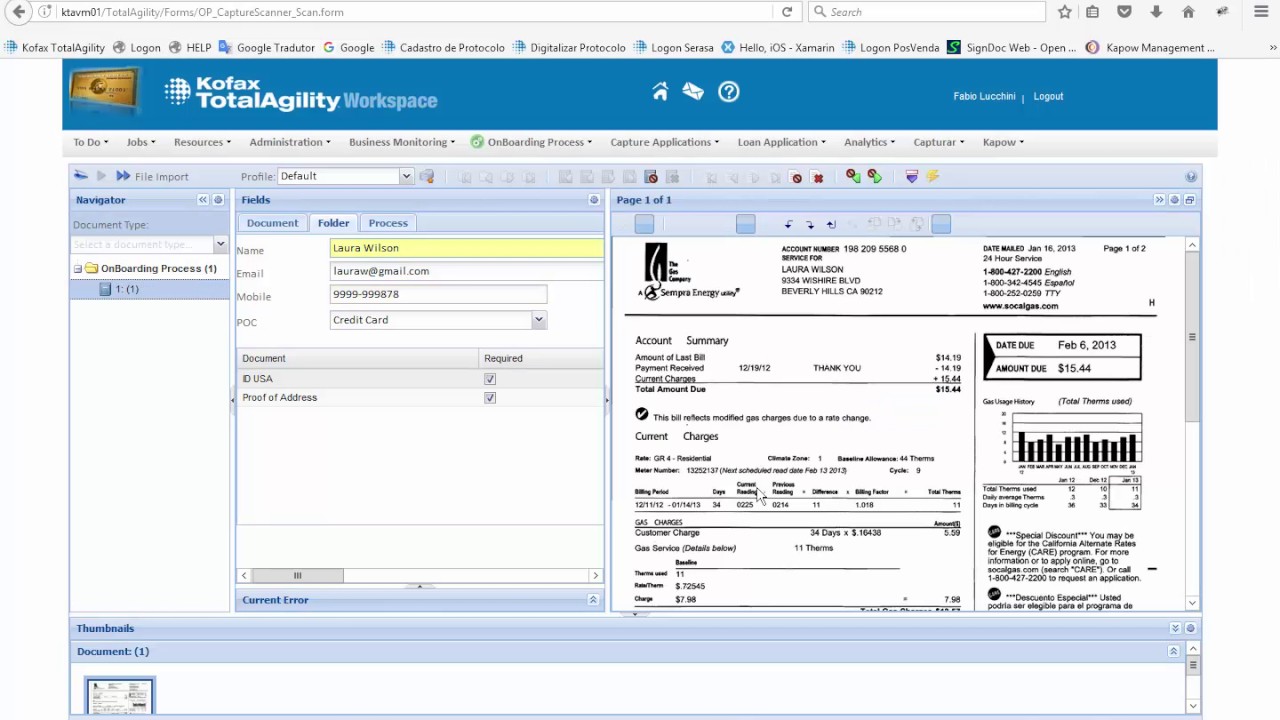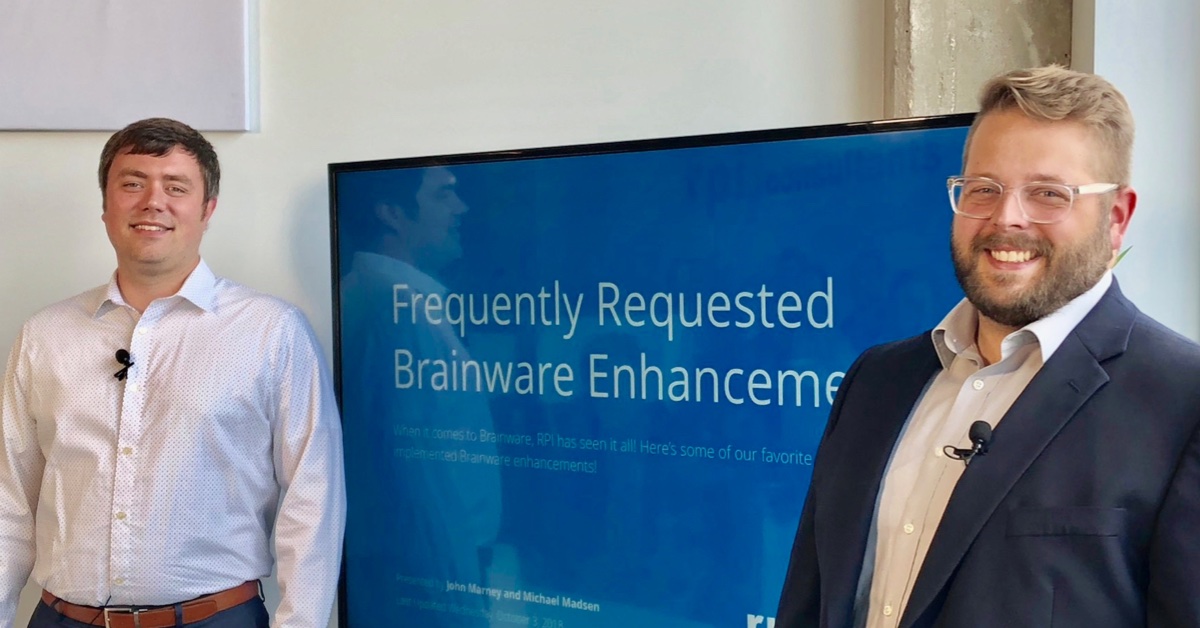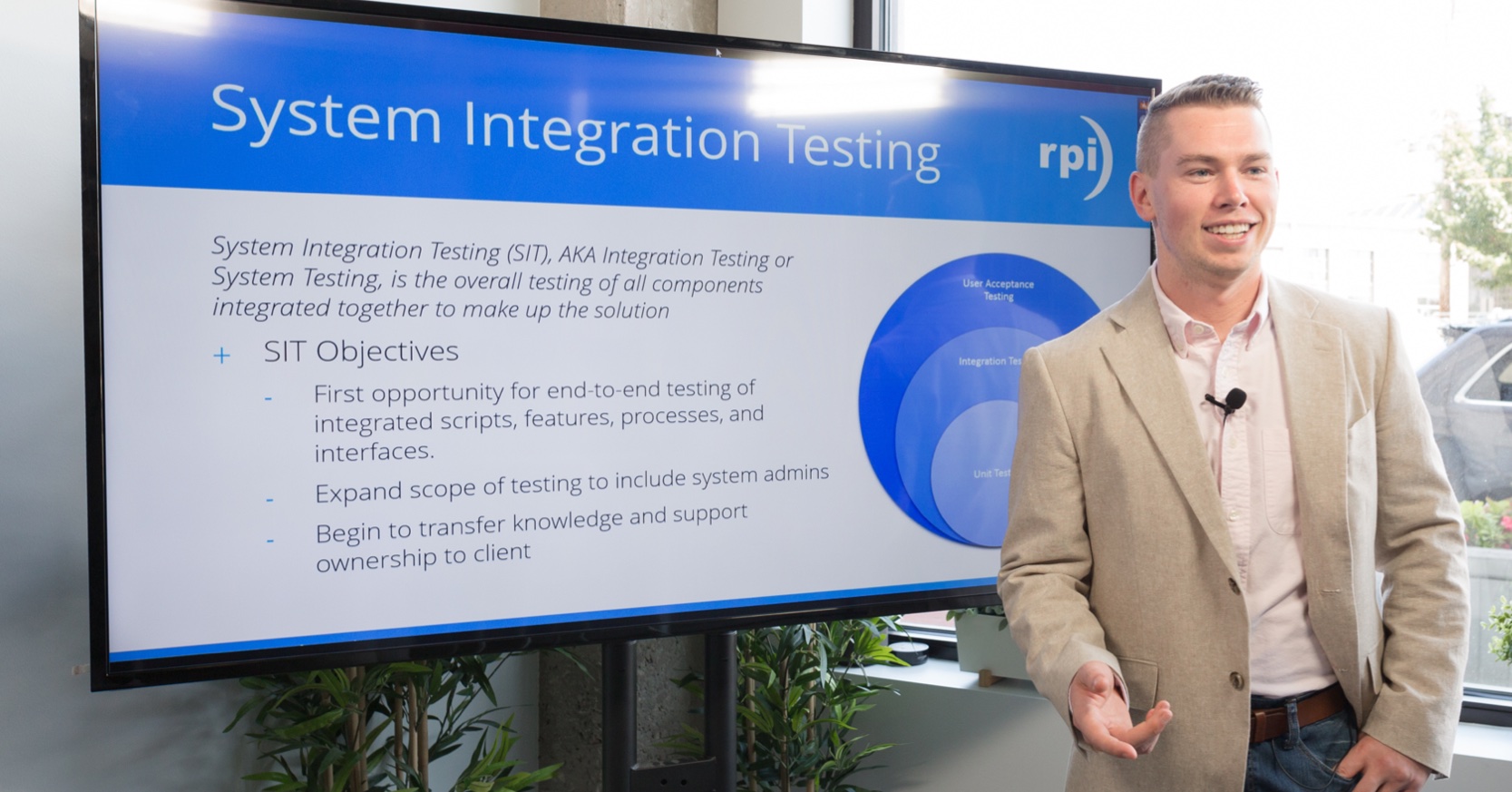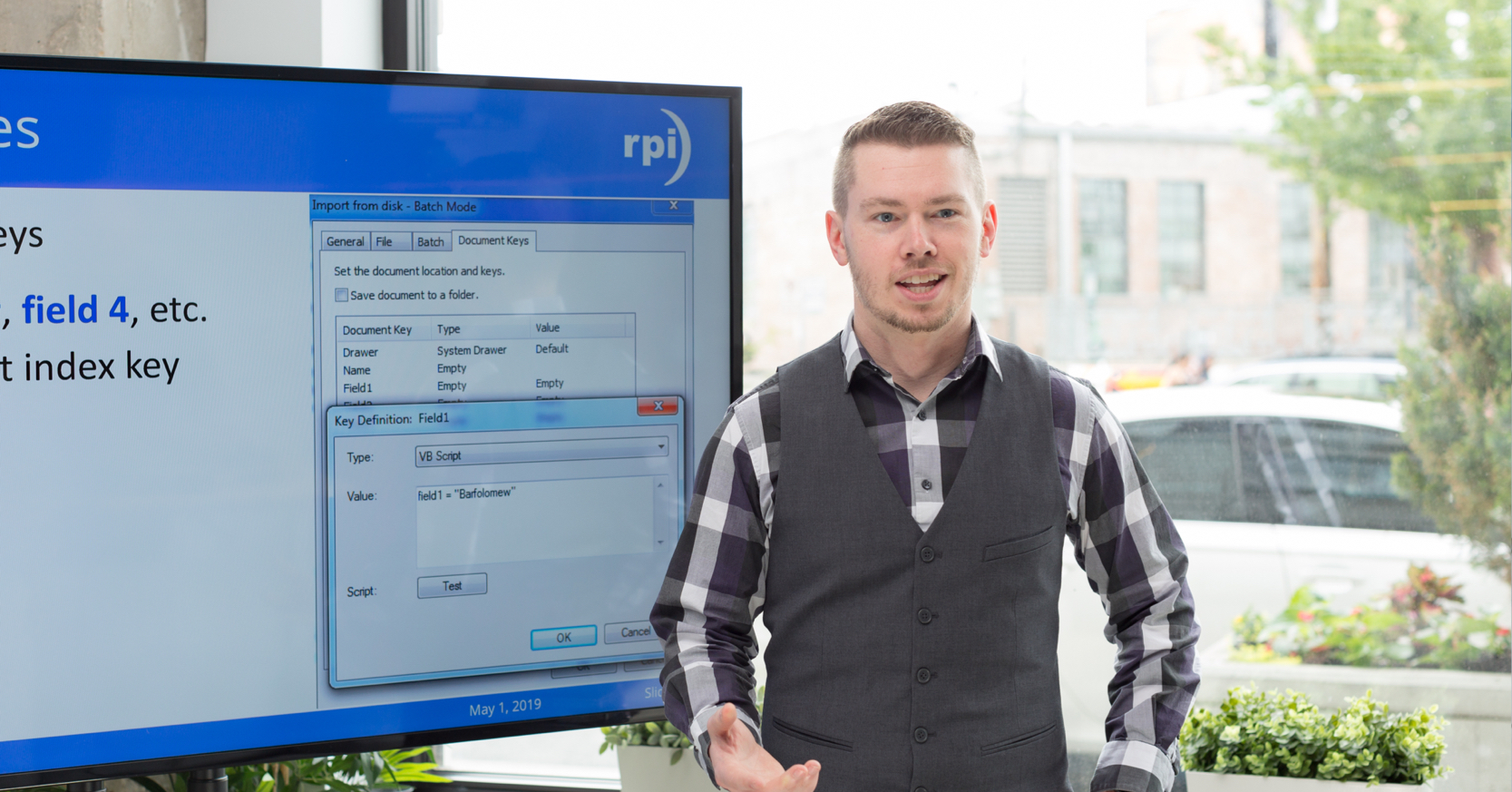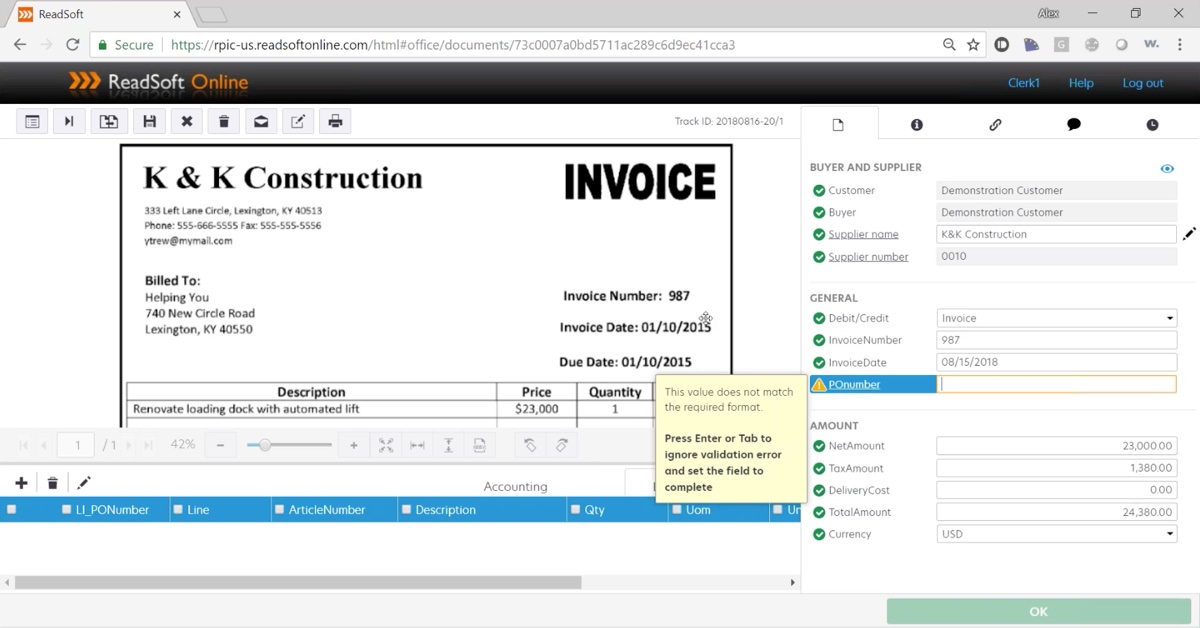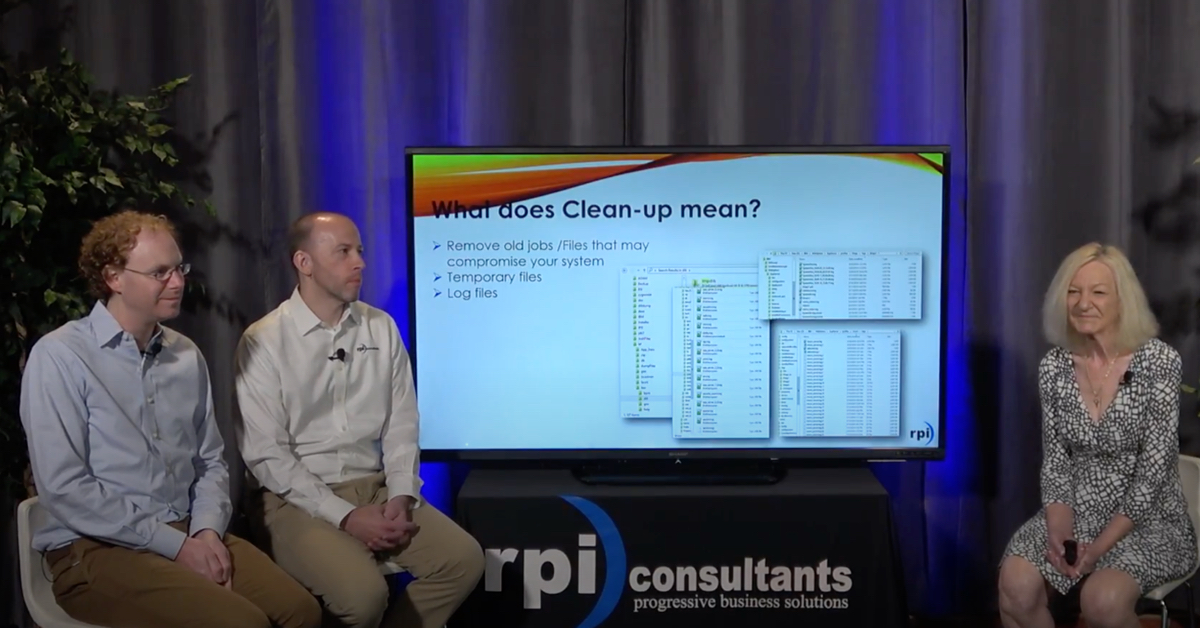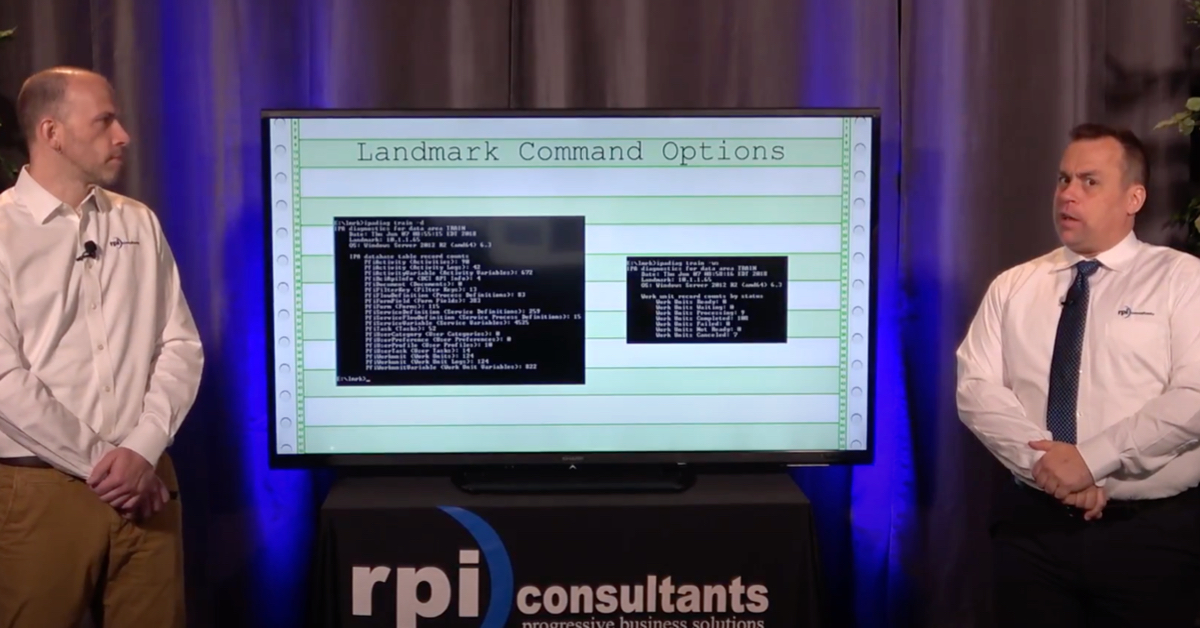The Business Case for v11 CloudSuite
CloudSuite v11 represents a major leap forward in technology and functionality that offers a very significant opportunity to address real pain points across all business areas in pretty much any organization. Join Richard Leigh Stout, a Partner at RPI and Chief Technologist, and Keith Wayland, RPI’s Managing Partner, for this webinar to review how v11’s powerful functionality – including flexible GL and HR Organizational structures, a single source for all Invoices and a modern Open Enrollment experience – can help your organization save time and money.
Transcript
Jackie:
Today we have for you Making the Case for v11, and with that I give you Mr. Keith Wayland and Mr. Richard Stout. Thank you.
Richard Stout:
Thank you.
Keith Wayland:
Thank you Jackie, really appreciate it and thank you to all of you that are taking a little bit of time to attend this webinar on Making the Case for v11.
Keith Wayland:
I remember towards the tail end of the version 10 cycle where we were approached with, “You know, somebody just needs to make the business case for going to version 10.” But ultimately version 10 was mostly … It was a technical project, right?
Richard Stout:
For sure.
Keith Wayland:
It was an infrastructure project.
Richard Stout:
Yeah.
Keith Wayland:
And the main reason to do that was to stay current and stay supported, and on the latest iterations, and take advantage of some of the smaller feature functionality-
Richard Stout:
And one of the main objectives of that project was to minimize end user disruption.
Keith Wayland:
Minimize end user disruption. For version 11 I think there will be more end user disruption. The good news is there’s a lot to gain out of going to version 11, right?
Richard Stout:
Yeah. Version 11 is a business disruptor.
Keith Wayland:
It is a business disruptor and a business improver, right? And what we want to talk about here today is how to go about making that business case in the way that makes sense for your organization. There are some things that are going to be pretty universal advantages to everyone, but there are certain items that are going to be more valuable to certain organizations than others. And how to go about identifying and quantifying what those opportunities are, so you can let that drive what your roadmap is for getting to version 11 and your investment looks like.
Richard Stout:
Yeah. Earlier today we emphasized that Lawson customers should have a plan for how they’re going to move their organization forward. And you can consider this webinar a tool in that toolbox, of helping our clients be prepared to talk about what their plans are for the future.
Keith Wayland:
But first Bill Geddy forces us to put something about RPI, which is not so bad. So in a nutshell RPI is a group of consultants that really like to do cool projects, we work very hard for our customers. We’re certainly not perfect but we try to build long-term relationships and deliver as much value as we can, right? That it in a nutshell?
Richard Stout:
In a nutshell. I mean, we’re closing in on our 20th anniversary-
Keith Wayland:
We are. Yes we are. Next year. It’ll be next-
Richard Stout:
Next year.
Keith Wayland:
… October, yeah.
Richard Stout:
It will be exciting.
Keith Wayland:
Mm-hmm (affirmative).
Richard Stout:
I have been here through most of that and I’ve seen RPI grow. To me what’s been really exciting is our growth has been organic and has been driven by-
Keith Wayland:
Finding good people.
Richard Stout:
… finding the right people, right?
Keith Wayland:
Yep.
Richard Stout:
So hiring really smart people who are really passionate about what they do, listening to them, and building that intellectual capital. And we’re really excited to have the opportunity to put that intellectual capital to use for our clients today.
Keith Wayland:
Absolutely. So when we look at today’s agenda we’re going to frame the business problem and then we’re going to dive pretty deep into the business opportunity, and what that looks like, and what to search for your organization. We’re going to talk a little bit about risks and a calculated return on investment. And then we’re going to recommend an approach to get started.
Richard Stout:
Right.
Keith Wayland:
So, I mean, the first thing is … When we’re framing the problem is, is there a problem? I mean, you have a working system today and, presumably, vendors are getting paid, and purchase orders are going out, and people are getting hired, and HR personnel actions are occurring. So it’s not that you have a broken system, it’s that there are new, more evolved, systems. And by not having a best-of-class system you may have a lot of manual processes today, that lack visibility and transparency, that you can automate to repurpose some of your organizational resources.
Richard Stout:
So the problem comes down to not absolutely maximizing the potential of the systems and technology that could be in place. Even if you’re running a very stable, well-tuned Lawson 10 system, hey the goalposts have changed, right?
Keith Wayland:
Absolutely.
Richard Stout:
If you take a look at what’s out there in the market you need to be on a system that compares favorably to everything that’s out there and would be available for a new implementation.
Keith Wayland:
And that market, your competitors, they are changing. So right now that may not be as large, because a lot of your competitors may be in similar type systems, but next year and the year after, and within five years, that’s going to continue to expand, right? So really the business problem is not having a best-of-class system, as CloudSuite version 11 can offer.
Keith Wayland:
Two major areas that we’re just going to take a quick dive into is why are there these process inefficiencies? The first thing is older ERPs were more transaction driven solutions, right?
Richard Stout:
Mm-hmm (affirmative).
Keith Wayland:
It’s a giant database and most of the process got designed by consultants like ourselves, and live outside the system, and are powered sometimes by third-party solutions or organizational knowledge.
Keith Wayland:
Another big thing that we find is that we’re at the tail end of a major ERP cycle that was powered by Y2K. So not all of you, but a lot of you probably implemented in the late ’90s or early 2000s, so about 20 years ago. Which is, by the way, considered the lifecycle of an ERP, 20, 25 years. Capital like that investment, get ready to make a new one. And you are living, probably, with design decisions that were made then, based on what your organization looked like then, which, at least for us, would be very different and for a lot of you as well.
Keith Wayland:
And also the constraints that the software had, right? A simple thing like a GL code block is, “Here’s your company account, accounting unit, maybe a sub-account, how do we make this work,” right?
Richard Stout:
Yeah.
Keith Wayland:
You also … I think there’s a big opportunity here, is when you implemented it you probably didn’t have Lawson experts in-house at the time that were familiar with the system. When you look at migrating to CloudSuite there is an opportunity to take all that intellectual capital that you’ve built, that is [inaudible 00:06:18] with whatever shortcomings the organization has faced, and to fix those. And that, to me, is sort of a very unique opportunity that doesn’t exist in all ERP cycles.
Richard Stout:
Yeah, it’s a once in a generation opportunity in the business world.
Keith Wayland:
Absolutely. Another thing that we look at is … Or that we hear from our customers is it’s sometimes challenging to get data in a rapid useful way, right?
Richard Stout:
Mm-hmm (affirmative).
Keith Wayland:
So it’s both how many layers does it have to go through to get to the person that is making a decision and how interactive is it to make edits or changes to how we view, or look at, that data?
Keith Wayland:
You know I will say, and this is going to be sort of a recurring thing when we look at the different opportunities, is there are tasks going on in your organization today that they keep the lights on and they keep things moving but they are manual, duplicative, and not necessarily a value add. There’s an opportunity to take a big resource base in your organization and refocus it on the things that would give you a competitive advantage.
Richard Stout:
Absolutely.
Keith Wayland:
Another thing we’ll dive in a little bit is point solutions, is something that Stout and I have talked about a lot. Obviously the concept of an ERP is a common platform for all your business applications, is simply not a reality and isn’t likely to become one. However, I feel like there is extremes and at this point, I mean, there are organizations with over 100 point solutions in their business application footprint. And each one of those has its own vendor relationship, its own sets of master data that need to be integrated, a series of interfaces that need to be upgraded. So if I have 100 things that need to be upgraded I need to say, “Well I got to upgrade Z right after Y and right before X,” and I end up in this never ending cycle of just keeping this footprint current.
Keith Wayland:
So this is important because I don’t feel like we’re going to try to tell you that version 11 is going to replace all your point solutions, because it’s not, but it can replace some of them. It can replace some big ones and it could create a lot of inefficiencies, so think of it as balance. Maybe this thing doesn’t make sense to bring into version 11 but there’s two others that do, it reduces your footprint, it reduces your maintenance, it reduces your constant upgrade cycle, and it fights interface maintenance malaise, which we are officially coining here today.
Richard Stout:
Yeah.
Keith Wayland:
Okay. So let’s flip it, let’s look at what the opportunity is, right?
Richard Stout:
Mm-hmm (affirmative).
Keith Wayland:
Because that’s more fun to talk about. From a high level streamlining business processes so that people aren’t doing grunt work, essentially. There’s also, I think, more flexibility in version 11 to configure the system in such a way to allow you to more accurately reflect your organizational structure and needs, and then leverage that as you look at all the other business processes that are out there.
Richard Stout:
Yeah, totally. From both a financial standpoint, as well as a people standpoint.
Keith Wayland:
Absolutely. And, obviously, anywhere where you can reduce support; maintenance; hardware; professional services, secludes us, there’s going to be a benefit in hard dollars.
Keith Wayland:
So let’s dive into some of those a little bit more-
Richard Stout:
Okay.
Keith Wayland:
… what say you Mr. Stout?
Keith Wayland:
So at the very top of the hierarchy here we have, we’re calling it, total cost of ownership but we’re very focused on IT-centric costs and tasks, right?
Richard Stout:
Right.
Keith Wayland:
So from a cost perspective we have the hardware that this is sitting on and the fees for supporting that hardware, and then the work around that hardware. For example, one thing we’re doing for a lot of customers today is we’re migrating them from Windows 2008 to 2012, which requires a full reinstall and a migration, a good bit of professional services. And I keep wondering to myself, it’s like, it’s about to be 2019 when is Windows 2012 no longer going to be supported? You have any insight into that?
Richard Stout:
Yeah. It’s usually about a year after you complete a big server migration project is right when that next version opens up for you. I mean, I work with a whole team of consultants who are really excited to build stuff for our clients, to automate processes, to add new software-
Keith Wayland:
Add value.
Richard Stout:
… functionality, to add value. And they’re not that excited about doing platform migrations either, right?
Keith Wayland:
There you go. So I think that’s the real thing here, right? So there’s the direct cost, professional services, hardware, hardware changes, maintenance, but then there’s also the organizational cost of having resources that are dedicated towards keeping the lights on, right? So if you end up installing whatever, a smart office, 100 times over the course of five years there’s only so much value add there. And if you can take those IT resources and refocus them on internal projects that help the organization operate better, so deploying some of these delivered workflows and action requests, and continuing to integrate and automate, you’re constantly getting better. It’s the cycle of continuous improvement that we keep talking about and we really wholeheartedly believe in, and that’s what an IT department should be doing. It should be a value add center-
Richard Stout:
Exactly.
Keith Wayland:
… not a infrastructure center.
Richard Stout:
Right. I mean, who better than your own IT department to understand really where technology can come in and solve business problems, right?
Keith Wayland:
Mm-hmm (affirmative).
Richard Stout:
And on the flip side our IT departments are probably less well positioned to deal with a big operating system, or database, or platform changes, or other-
Keith Wayland:
Major changes in security-
Richard Stout:
Yeah.
Keith Wayland:
… protocols.
Richard Stout:
Exactly. I mean, there’s a whole laundry list of items that there are people out there, that’s their whole mission in life to focus on, and we can’t have every one of those people on staff at all times.
Keith Wayland:
What I’m hearing you say is that most people’s IT departments aren’t necessarily the foremost experts on migrating everything to ADFS, but they are the most foremost experts on their own internal business that they’ve been working for and supporting for years, right?
Richard Stout:
Yeah.
Keith Wayland:
And that’s where they truly have the value add.
Richard Stout:
Mm-hmm (affirmative).
Keith Wayland:
So moving over here, obviously big low-hanging fruit in moving to version 11, is to streamline reporting. We had a colleague we spoke with the other day, who often goes onsite and talks to people about their reporting pain points, and he asked them, “How much time do you spend getting data out of the system and slicing, dicing, putting together reports, building PDFs, distributing them?” And the answers he gets are anywhere between 25% and 60% of the time.
Keith Wayland:
Now, obviously, it’s a function of anybody that operates with any business application that you have to spend some time getting data out. But you have to wonder if you could take some of that time that’s spent just extracting and distributing, and actually acting upon the information that’s there and saying, “Well now that I know my contract compliance is low let me dig into why and start to put some processes in place to help it,” or, “Now that I see this division’s performing really well let me see if I can expand the investment there,” than just trying to get at the data.
Keith Wayland:
And, again, this reflects something that our customers talk to us a lot now. When you look at why version 11 is going to be … There’s a lot of layers of why it’s improved, not only the increased flexibility of structure, and roll-ups, and calendars, but the fact that these are all built into the system. So that data, where it occurs and exists, lives in such a way that makes it easier for your average power user to just extract themselves. And one of the things we talked about earlier today is you can have a list driven view, essentially, be a real time crystal report with filters, right?
Richard Stout:
Yeah.
Keith Wayland:
I mean, you’re replacing a lot here and you’re taking something that’s static and making it dynamic. So you want to add something there?
Richard Stout:
Well just to say that it doesn’t really make sense to have one system where you create and transact in data, and then a totally different system where you analyze and extrapolate from that data.
Keith Wayland:
Absolutely.
Richard Stout:
And that’s just been the way it’s been for a-
Keith Wayland:
It’s been a reality.
Richard Stout:
… long time because that was the technological capability. We’ve seen that barrier disappear over the past five years and CloudSuite certainly merges those two functions in a-
Keith Wayland:
[crosstalk 00:15:01] So an opportunity to take-
Richard Stout:
… high performing system.
Keith Wayland:
I’m sorry. An opportunity to take IT and refocus effort to value add task; opportunity to take finance, primarily, and some department managers-
Richard Stout:
Your business analysts.
Keith Wayland:
… business analysts, to focus on value add task. And then, similarly, an opportunity to take a lot of HR and refocus on value add task. And in HR we find that before we get into the structures there’s a lot of duplicate data entry that occurs.
Richard Stout:
Yeah. There’s a lot of time just managing the day to day personnel actions, and transfers, and hires, and terminations, and position changes.
Keith Wayland:
Answering the phone for simple questions, right?
Richard Stout:
Answering questions about benefits.
Keith Wayland:
So anything you can do to empower those employees and move that forward is going to be helpful. And there’s also the opportunity to create a structure that reflects your organization, both in terms of varying levels of depth, of different lines for approvals versus supervisors and performance reviews, and also the ability to bring non-W2 resources or third-parties in as having some level of responsibility where things roll up to them, right?
Richard Stout:
Yeah.
Keith Wayland:
So the ability to reflect that true organizational culture can have a lot of advantages.
Richard Stout:
Yeah, totally. There’s a lot of benefits of having all of the relationships between the different people, in our organization, defined and maintained in one place because that can power a lot of our-
Keith Wayland:
[crosstalk 00:16:37] True system, right.
Richard Stout:
… HR. True system … Right, it creates a true system record and that can power a lot of other higher level processes, and analysis, and things that happen. And I mentioned it earlier, having a shadow HR structure that powers approvals in a different system is certainly very inefficient and hard to maintain, and [inaudible 00:16:58] sort of solves that by enabling us to bring all of the different ways that people relate to each other in under one roof.
Keith Wayland:
So I think this starts with a conversation with your HR process owners, “What are the major pain points today? What are the major time investments that are not proactive to assist your business?” I mean, what you want HR to do is focus on turnover reduction and identifying the right talent to bring into your organization, not data entry and manually updating systems.
Keith Wayland:
So we also have an opportunity here around accounts payable, which is the consolidation of your preapproval invoice processes. And for a lot of organizations that’s currently powered through third-party systems, usually imaging workflow systems that have license and maintenance costs; and professional services, which we ourselves do some of, to keep them up to date and upgrade them. And you could potentially replace that because you have a system that can now handle all those things, which makes a lot of sense.
Richard Stout:
There’s a ton of out-of-the-box functionality with CloudSuite FSM when it comes to managing this process and lifecycle of the AP invoice, from the point that you receive it to the point that it’s posted and paid.
Keith Wayland:
Absolutely. And for some organizations that maybe don’t have that third-party system, that are doing this manually, well it’s time.
Richard Stout:
Right.
Keith Wayland:
1998 called and they want their manual processes back.
Richard Stout:
Yeah. And I get that implementing a standalone system to manage that, that’s a big project, but when that functionality is just backed in to CloudSuite FSM there’s a much lower barrier to entry.
Keith Wayland:
I mean, I think of the integration alone and it’s like it’s painful, it’s like, “Why?”
Richard Stout:
Sure. I’ve written a lot of that integration.
Keith Wayland:
You have. I know, I know, we have. We have but now we don’t need to and that’s exciting.
Richard Stout:
Yeah.
Keith Wayland:
Similarly, on the benefits side, there’s some significant savings to be had in open enrollment. The ability to substitute a third-party open enrollment administrator. I got to admit, we’re a professional services firm, I wasn’t familiar with just how expensive those are and I was shocked. And, also, there’s other organizations that use third-party software solutions for this or have extensive customizations, which you have to pay to build, and maintain, and migrate. So, I mean, there’s a really big opportunity to just straight up reduce cost there.
Keith Wayland:
And, again, this is just a conversation of how does open enrollment work today? Painfully, expensively. You can make it better. And at the end of the day there’s also the nice improvement of that employee experience, which we’re going to talk about a little bit more in a second.
Richard Stout:
Yeah.
Keith Wayland:
So those are some of the real high level, I think they’re going to be pretty universal, benefits. But there are hundreds of delivered approvals and action requests. Everything from journal entry approvals, which maybe your organization has discussed and not implemented, to vendor addition processes where people can add different pieces of information along the way that maybe had value but wasn’t worth building, that are now delivered.
Richard Stout:
Yeah. I mean, there are two big reasons why this really matters. One is it makes so much sense to have the item or record that we’re looking to add into the system, and the people responsible for approving or possibly contributing to that, both in the same system, along with the record of that transaction all in the system.
Richard Stout:
And then the other is the pervasive auditing and as-of dating functionality, where the system keeps track of exactly when data changed and who it was changed by. And it’s so easy to just adjust your perspective of what date are you looking at, to see what did things look like last quarter, last year or what are things going to look like on January 1st?
Keith Wayland:
Right. So fundamentally we believe that transparency helps organizations.
Richard Stout:
Mm-hmm (affirmative).
Keith Wayland:
Automate all the processes. I need like … Is that a broom, you think, that he has there?
Richard Stout:
Yeah.
Keith Wayland:
Or is that like a torch?
Richard Stout:
Oh, let’s go with broom.
Keith Wayland:
Broom, okay.
Richard Stout:
We’re cleaning up inefficiency, we are not burning the house down.
Keith Wayland:
So obviously, if you’re looking for hard dollars, a great place to find them is any point solution that you can consolidate into your version 11. Maintenance costs, support fees, professional service fees, interface maintenance effort. Maybe you have internal staff dedicated to just sustaining that, even if it’s just a quarter FDE. And version 11 can’t replace every business application that’s out there but it has some really robust, deep functionality across a breadth of different areas. So there’s definitely some opportunities in there. They may be more organization specific, whether it’s treasury and cash, or recruiting, or contract for you, but I definitely encourage everyone to create awareness around, “What is it that we can replace here,” and, “Hey, what’s the cost of that to us today?”
Richard Stout:
Right. So, I mean, beyond just looking at maintenance costs for all of these individual solutions, and when renewals might be up, and when might be a good time to transition out, what about the future cost of implementing a possible point solution that now you can implement that solution right within CloudSuite for a much lower cost.
Keith Wayland:
So then we have much improved self-service, employee space, employee manager, with additional functionality, pictures. I love pictures. And this sort of has a dual impact. One of them is you’re empowering employees and you’re reducing their drain … That’s a negative word. Let’s say something positive. You’re empowering employees and you are increasing HR’s time to dedicate to other types of activities that add value to the organization. And you’re also improving the internal customer experience. And by that we mean your employee base.
Richard Stout:
Yeah. And that’s super important today. For most of our clients their employees are their most important, most valuable-
Keith Wayland:
Critical, yep.
Richard Stout:
… asset, right? Retention’s really important, recruiting the right people, attracting the right talent is really important. And in today’s economy we have a very tight job market, this software-
Keith Wayland:
So I hear.
Richard Stout:
Yeah. Yeah. This software gives you a competitive edge to attract and retain the best talent in the market.
Keith Wayland:
Also, there is a whole host of other features that may apply in your organization, from inventory intelligence tools that can help you identify the right amount of stock on hand to carry, so that you don’t run out but you also don’t have more than you need and can reduce the overall value that’s sitting in inventory; to integrated solutions to help with onboarding, where you’re taking all the information that you’re capturing during the applicant interview process and then using that to power your HR record, and ultimately your user provisioning.
Richard Stout:
Yeah, totally. I mean, when we look at even little things like specials on a contract that Stephanie has been presenting on for a couple of years that-
Keith Wayland:
Yeah. She preaches, yeah.
Richard Stout:
… she preaches, that’s built right in to CloudSuite Financials. If we look at the document management aspect, basically in Infor OS comes with a document management system that allows you to-
Keith Wayland:
Attach.
Richard Stout:
… attach, store, categorize documents, PDFs, images and take advantage of the existing security model you have in the application, have an in context viewer, and it’s got document output capabilities as well. So you’ve got rich configurable templates for output for things such as purchase orders.
Keith Wayland:
Yeah. And things like automated leave request, which is something that we have custom developed for customers in the past, where you can, through employee self-service, make the request and then through manager self-service not only approve it but see who else is off at the same time so you can make sure that you’re going to have coverage. Some really cool stuff that’s out of the box.
Keith Wayland:
Now let’s talk about what are some of the risks in this undertaking?
Richard Stout:
Yeah. Well I think the greatest risk that we face here is moving to CloudSuite can be a costly, time intensive, project. It’s very transformational for an organization, it involves a lot of people. There will be very high expectations. There will be a lot of things on the wish list. And I think the greatest risk is working through a very expensive project that doesn’t deliver on everything that it promised, doesn’t bring about all of the improvements that we’ve talked about today.
Keith Wayland:
To me one of the biggest risk is, is we’re so used to these major upgrade cycles being technical projects, is to treat it as such and to minimize that disruption to the end user.
Richard Stout:
Yeah.
Keith Wayland:
Business owners, they’re going to get disrupted and it’s not a bad thing because it’s an opportunity to make things better. So, to me, it’s lack of engagement and buy in from process owners, that’s the biggest risk. They need to be a part and the driver, and they need to guide, “What is it we’re getting out of this,” and then everything else will be defined around that.
Richard Stout:
Yeah. That’s why it’s so important for us, as a consulting company, to make sure that our clients are-
Keith Wayland:
Are educated.
Richard Stout:
… educated and their whole team, and business owners, are engaged in this process, and planning, and designing what this new solution’s going to look like.
Keith Wayland:
Absolutely. One question we get all the time, and maybe a lot of you guys have thrown this out there, is what’s the ballpark cost for this? And it’s extremely challenging to provide a ballpark cost. A very wide range of cost, that we have already engaged [inaudible 00:27:39] and put out there, and has a lot to do with how big is your Lawson footprint today?
Richard Stout:
Sure.
Keith Wayland:
If you run just AP/GL then that’s very different than if you run [3Suites 00:27:51]. And what other solutions are you looking to get incorporated as part of this migration? The size of your organization makes a real big difference. And how much are you rethinking your chart of accounts or your organizational structure? Do you have companies documented? Where are you on jobs and positions? What level of business process redesign are you expecting to undertake? And there’s also the volume and sophistication of your reporting infrastructure, your integrations. And a lot of those things will have to be at least touched.
Keith Wayland:
For the sake of not totally shying away I’ll say that, hey, if you want to have a starting point, a ballpark, it’s about one to 1.5 million in professional services for each CloudSuite HCM and CloudSuite Financials. And that would be for like a medium sized organization, so think about 5,000 employees, about a billion dollars in revenue. If you’re smaller than that it’s definitely going to be less. If you are a large, multi-hospital system, it’s definitely going to be more.
Keith Wayland:
And just along those same medium sized organization we would say about a 12 month timeline for each, but we highly recommend phasing. It’s been something that’s been very successful for us over the years. When you do a big bang you create a lot of interdependencies. And the worst thing that can happen is that your project delays because of one area and another area, that was ready to go, loses momentum, right?
Richard Stout:
Yeah.
Keith Wayland:
They lose the recent touchpoints and the drivers, and then it sort of just all unravels.
Keith Wayland:
So as far as calculating the return on investment there are a lot of direct cost savings to be had and we’ve talked about a lot of these already. There are things that you can start cataloging and categorizing, within your organization, to understand what these different things are costing. And you can look at, “What’s the professional services for the last five, 10 years? Is it going to be the same for the next five, 10 years or is it going to be more, potentially?”
Keith Wayland:
And also, obviously, the time that can be reallocated. That time has value. We’re not saying you get rid of people. We’re saying those people are the most valuable people to your organization and you are constrained on how many people you can hire, and getting the right talent. Use the talent that you have better. And that doesn’t mean just get more out of them, it means get different out of them.
Keith Wayland:
There are also some competitive advantages in, not only, potentially reducing turnover but increasing compliance by making a friendly system to operate in, one that aligns more with their experience as consumers in the everyday world, in 2018 and 2019. And hopefully, our real goal is to get increased insight into what’s working in your business and what’s not, so that that’s what your investing your time in. It should be a guide to, “This is what you should be looking at, or investing in, or rethinking.”
Richard Stout:
Yeah. It’s putting a value on that tactical operational business intelligence that CloudSuite offers, as well as more of the strategic forward looking insights that we can gain from this system.
Keith Wayland:
Excellent. So from a recommended approach, if you’re looking at doing this in 2020, 2021, 2019 is a great year to start planning. And our number one recommendation is engage process owners on CloudSuite capabilities. I can’t tell you how many times I’ve shown someone one of these functions and they’re like, “Wow, it can do that?” And it’s like, “Yeah, it can do that.” “That would relieve so much pain, that would reduce so much cost.” So as an IT department, anybody of you watching in IT department, go find out what those pain points are, educate them on what they can solve, and start putting some costs around it. That’s what’s going to drive this.
Keith Wayland:
Also want to calculate that IT infrastructure cost, engage with Infor to get some pricing to understand what this is going to look like. CloudSuite is not point driven as old school Lawson was, it’s a packet so you’re going to get a lot more functionality than you have today. Not all of which you’ll use but it’ll all be there. And then map out what the five, 10 years look like in either direction.
Keith Wayland:
Now the other thing that’s helpful when you go look for professional service ballparks or real estimates, or RFIs, is to really have a good catalog of what you’ve got, in terms of reporting, and workflows, and interfaces. That’s really helpful to us to try to gauge what the effort is. How much of that you can handle internally, if the resources that develop these are on your team and they have availability, that really reduces your professional service costs.
Keith Wayland:
With customizations I’ll say one of the worst thing is when we get a list of like, “Here’s some 4GL tokens. Well, I don’t know what’s applicable here, what really matters is what was the business gap?
Richard Stout:
Right. What was the requirement that this solved, that wasn’t present in the application, and is it possible that CloudSuite does offer that feature, or ability, or a way to accomplish that without-
Keith Wayland:
It’s much easier to map …
Richard Stout:
… any level of customization.
Keith Wayland:
… a requirement to something that CloudSuite meets than a 4GL token to something, whether you need it or not.
Keith Wayland:
And then, obviously, conversion requirements, you’re going to have a big impact. Obviously we like to think, “Hey, we’re going to bring everything over,” but that is going to have either a resource effort or a consulting cost. Generally speaking you should be thinking about bringing several years of GL trans. And, by the way, it’s a big difference if you’re posting in detail and you have 20 million transactions, and GL trans, per year or 100,000, so knowing volume is important.
Keith Wayland:
And as far as your subsystems, again, engage those process owners, find out what they really need. Do they need one year’s worth of personal actions or they need 15, right? There’s other ways to get this historical data available, and if it’s not something that you’re not looking at every day it might not be worth all the money to try to retrofit it all-
Richard Stout:
It’s a lot cheaper to have it in a cold storage, inquiry only, area-
Keith Wayland:
Absolutely.
Richard Stout:
… rather than in a live application.
Keith Wayland:
Absolutely. Absolutely. So with that, if there are any questions, we will be happy to take them.
Speaker 4:
There are several. First of all, “Will there be future webinars addressing the benefits of SCM?”
Keith Wayland:
Sure.
Speaker 4:
“Using Infor version 11?”
Keith Wayland:
Yes, absolutely. We in no way meant to shortchange SCM.
Speaker 4:
And this is maybe a more technical-
Keith Wayland:
That’s not Stephanie that asked that right?
Speaker 4:
No.
Keith Wayland:
Okay.
Speaker 4:
“Is Infor OS available on-premise?”
Richard Stout:
Yeah. Infor OS is available on-prem.
Speaker 4:
And lastly is kind of a comment and a question.
Keith Wayland:
Okay.
Speaker 4:
“Love what you’ve presented today, but I’m not sure we can pull off the business case on our own. Can you assist us in developing this and educate our leadership about the opportunity?”
Keith Wayland:
So obviously the answer is absolutely. This is something that we want to help customers with, we want to get them on the right path, whatever that path might be. Thank you very much. We hope you found this informative and helpful.
Want More Content?
Sign up and get access to all our new Knowledge Base content, including new and upcoming Webinars, Virtual User Groups, Product Demos, White Papers, & Case Studies.
Entire Knowledge Base
All Products, Solutions, & Professional Services
Contact Us to Get Started
Don’t Just Take Our Word for it!
See What Our Clients Have to Say

Denver Health
“RPI brought in senior people that our folks related to and were able to work with easily. Their folks have been approachable, they listen to us, and they have been responsive to our questions – and when we see things we want to do a little differently, they have listened and figured out how to make it happen. “
Keith Thompson
Director of ERP Applications

Atlanta Public Schools
“Prior to RPI, we were really struggling with our HR technology. They brought in expertise to provide solutions to business problems, thought leadership for our long term strategic planning, and they help us make sure we are implementing new initiatives in an order that doesn’t create problems in the future. RPI has been a God-send. “
Skye Duckett
Chief Human Resources Officer

Nuvance Health
“We knew our Accounts Payable processes were unsustainable for our planned growth and RPI Consultants offered a blueprint for automating our most time-intensive workflow – invoice processing.”
Miles McIvor
Accounting Systems Manager

San Diego State University
“Our favorite outcome of the solution is the automation, which enables us to provide better service to our customers. Also, our consultant, Michael Madsen, was knowledgeable, easy to work with, patient, dependable and flexible with his schedule.”
Catherine Love
Associate Human Resources Director

Bon Secours Health System
“RPI has more than just knowledge, their consultants are personable leaders who will drive more efficient solutions. They challenged us to think outside the box and to believe that we could design a best-practice solution with minimal ongoing costs.”
Joel Stafford
Director of Accounts Payable

Lippert Components
“We understood we required a robust, customized solution. RPI not only had the product expertise, they listened to our needs to make sure the project was a success.”
Chris Tozier
Director of Information Technology

Bassett Medical Center
“Overall the project went really well, I’m very pleased with the outcome. I don’t think having any other consulting team on the project would have been able to provide us as much knowledge as RPI has been able to. “
Sue Pokorny
Manager of HRIS & Compensation
MD National Capital Park & Planning Commission
“Working with Anne Bwogi [RPI Project Manager] is fun. She keeps us grounded and makes sure we are thoroughly engaged. We have a name for her – the Annetrack. The Annetrack is on schedule so you better get on board.”
Derek Morgan
ERP Business Analyst

Aspirus
“Our relationship with RPI is great, they are like an extension of the Aspirus team. When we have a question, we reach out to them and get answers right away. If we have a big project, we bounce it off them immediately to get their ideas and ask for their expertise.”
Jen Underwood
Director of Supply Chain Informatics and Systems
Our People are the Difference
And Our Culture is Our Greatest Asset
A lot of people say it, we really mean it. We recruit good people. People who are great at what they do and fun to work with. We look for diverse strengths and abilities, a passion for excellent client service, and an entrepreneurial drive to get the job done.
We also practice what we preach and use the industry’s leading software to help manage our projects, engage with our client project teams, and enable our team to stay connected and collaborate. This open, team-based approach gives each customer and project the cumulative value of our entire team’s knowledge and experience.
The RPI Consultants Blog
News, Announcements, Celebrations, & Upcoming Events
News & Announcements
Navigate ERP Changes With The Help of a RICE Inventory
Chris Arey2023-08-28T16:39:41+00:00August 22nd, 2023|Blog|
RPI Consultants Takes Workforce Management Practice to New Heights with Full-Service Delivery Capabilities
Chris Arey2024-05-07T17:53:14+00:00August 15th, 2023|Blog, Press Releases|
Why ERP Data Quality Matters During a CloudSuite Implementation
Chris Arey2023-08-09T16:03:38+00:00August 8th, 2023|Blog|
The 9 Key AP Automation Benefits Your Business Needs
Chris Arey2023-07-25T18:53:20+00:00July 25th, 2023|Blog|
RPI Consultants Expands Yoga Flexible Software with AI, Empowering Organizations with Cutting-Edge Technology
Chris Arey2024-05-07T17:54:31+00:00July 18th, 2023|Blog, Press Releases|
High Fives & Go Lives
Upcoming Events
RPI Consultants Presenting on Capital and Service Automation at TNLUG
RPI Consultants2024-02-26T06:21:35+00:00February 14th, 2013|Blog, Virtual Events, User Groups, & Conferences|


